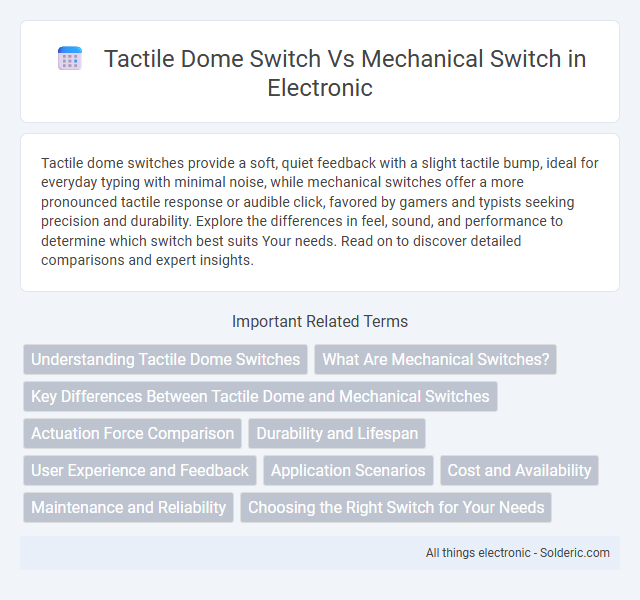Tactile dome switches provide a soft, quiet feedback with a slight tactile bump, ideal for everyday typing with minimal noise, while mechanical switches offer a more pronounced tactile response or audible click, favored by gamers and typists seeking precision and durability. Explore the differences in feel, sound, and performance to determine which switch best suits Your needs. Read on to discover detailed comparisons and expert insights.
Comparison Table
| Feature | Tactile Dome Switch | Mechanical Switch |
|---|---|---|
| Actuation Type | Membrane with tactile feedback | Individual mechanical spring and stem |
| Durability | Typically 1-5 million keystrokes | Usually 50-100 million keystrokes |
| Feedback | Tactile bump, soft | Distinct tactile and/or audible click |
| Travel Distance | Short (~2 mm) | Varies (3-4 mm average) |
| Noise Level | Quiet | Ranges from quiet (linear) to loud (clicky) |
| Cost | Lower cost | Higher cost |
| Customizability | Limited options | High customizability (switch type, actuation force) |
| Use Case | General office keyboards, budget devices | Gaming, professional typing, enthusiast keyboards |
Understanding Tactile Dome Switches
Tactile dome switches feature a rubber dome mechanism that provides a distinct tactile bump when pressed, signaling key activation without the loud click of mechanical switches. These switches offer a quieter typing experience and lower manufacturing costs, making them common in membrane keyboards and budget-friendly devices. Despite their shorter lifespan and less precise actuation compared to mechanical switches, tactile dome switches remain popular for office environments and portable keyboards due to their balance of feedback and affordability.
What Are Mechanical Switches?
Mechanical switches are individual, spring-loaded components beneath each keycap, designed to provide precise tactile feedback and audible clicks when pressed. These switches come in various types such as linear, tactile, and clicky, each offering unique actuation force and travel distance tailored to different typing preferences. You can expect greater durability and responsiveness from mechanical switches compared to tactile dome switches, making them ideal for gaming and prolonged typing sessions.
Key Differences Between Tactile Dome and Mechanical Switches
Tactile dome switches utilize a rubber membrane that provides a tactile bump without a distinct click, resulting in a quieter typing experience and shorter lifespan compared to mechanical switches. Mechanical switches feature individual spring-loaded mechanisms beneath each key, offering precise tactile feedback, audible click options, and greater durability with millions of keystrokes. Key differences include actuation force, lifespan, sound profile, and overall typing feel, with mechanical switches favored for gaming and professional use due to their accuracy and longevity.
Actuation Force Comparison
Tactile dome switches typically require an actuation force ranging from 45 to 60 grams, providing a lighter and quieter keypress experience. Mechanical switches vary widely in actuation force, with popular types like Cherry MX Reds needing around 45 grams and Cherry MX Blues up to 60 grams, offering more tactile feedback and durability. Your choice between these switches should consider the preferred actuation force for typing speed and comfort.
Durability and Lifespan
Tactile dome switches typically offer a lower durability with an average lifespan of around 5 million key presses, making them suitable for light to moderate use. Mechanical switches are known for superior durability, often lasting between 50 to 100 million keystrokes, which provides longevity for heavy or professional typing needs. Choosing the right switch impacts your device's lifespan and performance, especially if extensive typing or gaming is involved.
User Experience and Feedback
Tactile dome switches offer a soft, quiet feedback with a noticeable bump, making them ideal for users who prefer subtle tactile cues during typing or gaming sessions. Mechanical switches provide a more distinct and consistent tactile response with audible clicks or strong feedback, enhancing precision and user satisfaction for enthusiasts and professionals who value responsiveness. The user experience differs significantly, as tactile dome switches prioritize quiet operation, while mechanical switches focus on durability and pronounced feedback.
Application Scenarios
Tactile dome switches are commonly used in consumer electronics such as remote controls, calculators, and membrane keyboards due to their cost-effectiveness and quiet operation. Mechanical switches find applications in high-performance gaming keyboards, industrial control panels, and professional typing environments where durability and precise tactile feedback are critical. The choice between tactile dome and mechanical switches depends on the balance between budget constraints and the need for responsiveness and longevity in the specific application.
Cost and Availability
Tactile dome switches are generally more cost-effective and widely available due to their simple construction and mass production in consumer electronics. Mechanical switches tend to be pricier because of their intricate design and use of high-quality materials, which also limits their availability to specialized retailers. Your choice will depend on whether budget-friendly, easy-to-source options or premium durability and performance are the priority.
Maintenance and Reliability
Tactile dome switches require less maintenance due to their simpler design and sealed construction, reducing the risk of debris intrusion that can cause malfunction. Mechanical switches offer superior reliability with longer lifespans, often rated for tens of millions of keystrokes, making them ideal for heavy use environments. Performance degradation in tactile domes is common over time as the rubber dome weakens, whereas mechanical switches maintain consistent actuation force and feedback throughout their lifespan.
Choosing the Right Switch for Your Needs
Tactile dome switches offer a quiet, cost-effective solution with a soft tactile bump ideal for office environments or casual typing. Mechanical switches provide a more durable, precise experience with customizable feedback and actuation force, perfect for gamers and heavy typists. Your choice depends on whether you prioritize quiet operation and affordability or tactile responsiveness and longevity.
tactile dome switch vs mechanical switch Infographic

 solderic.com
solderic.com